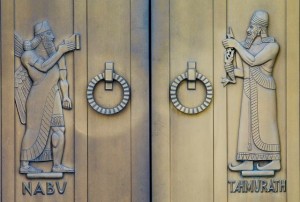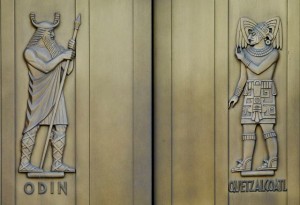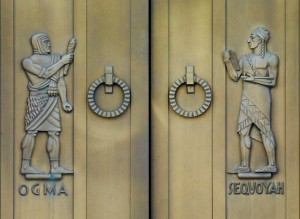In an earlier post I mentioned that the bronze doors greeting our patrons depicted the history of the written word through the sculpted figures. Perhaps, like me, you wondered how those figures actually represented the history of the written word and whether they were mythological or real.
While researching this building we ran across an older brochure (pre 1975) titled “The Bronze Doors of the Library of Congress.” This brochure and the Encyclopaedia Britannica provide some insight on the figures portrayed and their significance to the written word:
Thoth, in Egyptian mythology he was held to be the inventor of writing, the creator of languages, interpreter, and adviser of the gods.
Ts’ang Chieh, (aka Cangjie) is the Chinese patron saint of pictographic letters.
 Nabu, Sumero-Akkadian god of the stylus. Nabu was the patron of the art of writing and his symbols were the clay tablet and the stylus.
Nabu, Sumero-Akkadian god of the stylus. Nabu was the patron of the art of writing and his symbols were the clay tablet and the stylus.
Tahmurath, a Persian deity who was taught the art of writing in 30 different languages by the defeated demons in return for sparing their lives.
 Hermes, Greek god with many attributes, among which was the invention of the alphabet and numbers.
Hermes, Greek god with many attributes, among which was the invention of the alphabet and numbers.
Itzamna, chief god of the Mayas, said to have been a hero who gave humankind writing and the calendar and was patron deity of medicine.
Brahma, supreme god of the East Indian trinity, said to have brought the knowledge of letters to the human race.
 Odin, in Norse mythology the originator of the science of written communication. Odin was the great magician among the gods, and also the god of poets.
Odin, in Norse mythology the originator of the science of written communication. Odin was the great magician among the gods, and also the god of poets.
Quetzalcoatl, serpent god said to have been the founder of Aztec culture. In Aztec times he was revered as the patron of priests, the inventor of the calendar and of books, and the protector of goldsmiths and other craftsmen.
Cadmus, honored in Greek legend as the one who brought the alphabet from Phoenicia to Greece.
Ogma, in the mythology of prehistoric Eire the inventor of letters and designer of the alphabet. Ogham script, an Irish writing system from 4th century CE, seems to have been named for him.
designer of the alphabet. Ogham script, an Irish writing system from 4th century CE, seems to have been named for him.
Sequoyah, famous American Indian who invented an alphabet for the Cherokee language and taught his people to read. First experimenting with pictographs and then symbols adapted from English, Greek and Hebrew letters to represent the syllables of the spoken Cherokee language.
Also noted in the portion of the brochure displayed above are the figures on our south doors, the male figure representing physical labor and the female symbolizing intellectual labor. To research these figures further, follow the links to other materials in our catalogs.
Special thanks to Ellen Terrell, Business Reference Specialist, for her assistance with this material and to Jennifer Harbster (my co-blogger) for discovering the brochure!


December 4, 2009 at 11:17 am
Remarkable! So much rich history in these lovely doors…
December 4, 2009 at 1:07 pm
Very interesting!
This is very helpful since I have been writing to my children about my personal observations from my visits to the three buildings of the Library of Congress.
Thank you very much
December 6, 2009 at 4:07 am
hi
this is somthing very cool m an indian n i was very glad to see these bronze doors sitting here in ma pc keep up……
thank you
December 6, 2009 at 4:09 am
hello
im very glad to know about such history of bronze doors its really cool.
Thank You
December 7, 2009 at 9:19 am
Thank you so much for doing the research and informing us all.